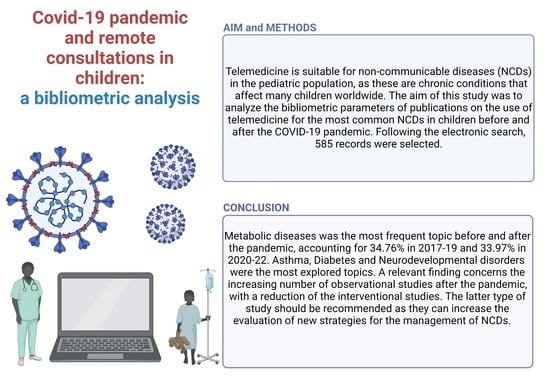COVID-19 Pandemic and Remote Consultations in Children: A Bibliometric Analysis
Abstract
:1. Introduction
2. Materials and Methods
2.1. Study Design
2.1.1. Inclusion Criteria
- Publication date from 1 July 2017 to 30 June 2022;
- Abstracts, conference papers, and editorial written in English; papers written in any language with an abstract in English;
- Papers published in journals, books, or conference booklets;
- Studies including pediatric populations.
2.1.2. Exclusion Criteria
- Publication date not in the inclusion criteria range;
- Studies that only considered adult populations.
2.1.3. Electronic Search
- for Medline: (“non communicable disease-” [tiab] OR “NCDs” [tiab] OR “caries” [tiab] OR “decay” [tiab] OR “G6PD deficiency” [tiab] OR “favism” [tiab] OR “atopic dermatitis” [tiab] OR “acne” [tiab] OR “premenstrual syndrome” [tiab] OR “tension type headache” [tiab] OR “anxiety disorder-” [tiab] OR “adhd” [tiab] OR “migraine” [tiab] OR “asthma” [tiab] OR “conduct disorder-” [tiab] OR “autism” [tiab] OR “major depression” [tiab] OR “major depressive disorder*” [tiab] OR “pyoderma” [tiab] OR “psoriasis” [tiab] OR “contact dermatitis” [tiab] OR “epilepsy” [tiab] OR “diabetes” [tiab]) AND (“telemedicine” [mh] OR “remote consultation” [tiab] OR “telemedicine” [tiab] OR “tele health” [tiab] OR “tele-health” [tiab] OR “telehealth” [tiab] OR “remote patient-” [tiab] OR “teleclinics” [tiab]) NOT (“pregnant” [tiab] OR “pregnancy” [tiab]);
- for Embase: (‘non communicable diseases’:ab OR ‘ncds’:ab OR ‘caries’:ab OR ‘decay’:ab OR ‘g6pd deficiency’:ab OR ‘favism’:ab OR ‘atopic dermatitis’:ab OR ‘acne’:ab OR ‘conduct disorder*’:ab OR ‘contact dermatitis’:ab OR ‘pyoderma’:ab OR ‘psoriasis’:ab OR ‘premenstrual syndrome’:ab OR ‘tension type headache’:ab OR ‘anxiety disorders’:ab OR ‘adhd’:ab OR ‘autism’:ab OR ‘epilepsy’:ab OR ‘major depression’:ab OR ‘major depressive disorder’:ab OR ‘migraine’:ab OR ‘asthma’:ab OR ‘diabetes’:ab) AND (‘remote consultation’:ab OR ‘telemedicine’:ab OR ‘tele health’:ab OR ‘tele-health’:ab OR ‘telehealth’:ab OR ‘remote patient-’:ab) NOT (‘pregnant’:ab OR ‘pregnancy’:ab) AND ([newborn]/lim OR [infant]/lim OR [child]/lim OR [preschool]/lim OR [school]/lim OR [adolescent]/lim);
- for Web of Science: ((ts = (non communicable diseases OR dental caries OR glucose 6 phosphate dehydrogenase OR favism OR atopic dermatitis OR acne OR pyoderma OR premenstrual syndrome OR tension headache OR anxiety disorder OR adhd OR major depression OR migraine OR asthma OR diabetes OR conduct disorder OR psoriasis OR contact dermatitis OR autism OR epilepsy OR diabetes)) AND ALL = (telemedicine)) AND ALL = (child* OR pediatri*).
2.2. Data Analysis
- Type of publication: article, conference paper, conference abstract, conference review, book chapter, or thesis.
- Main topic (i.e., which NCD). The authors labeled the NCDs according to PubMed’s medical subject headings in the following topics: asthma, brain disorders, mental disorders, dental caries, metabolic diseases, neurodevelopmental diseases or disorders, and skin diseases.
- Type of study: case report/series; guidelines/consensus paper; interventional studies; observational studies; review/meta-analysis; study protocol/pilot study.
- Clinical query: diagnosis, prevention, treatment, follow up, and diagnosis plus treatment/follow up.
2.3. Statistical and Visual Analysis
3. Results
4. Discussion
5. Conclusions
Supplementary Materials
Author Contributions
Funding
Informed Consent Statement
Data Availability Statement
Conflicts of Interest
References
- Baker, J.; Stanley, A. Telemedicine Technology: A Review of Services, Equipment, and Other Aspects. Curr. Allergy Asthma Rep. 2018, 18, 1–8. [Google Scholar] [CrossRef] [PubMed]
- Lee, J.; Carlson, E.; Demeterco-Berggren, C.; Corathers, S.; Jimenez-Vega, J.; Vendrame, F.; Weinstock, R.; Ebekozien, O. Challenges to telemedicine transition during COVID-19; insights from 21 us diabetes and endocrinology clinics. Diabetes Technol. Ther. 2021, 23 (Suppl. 2), A45–A46. [Google Scholar]
- Weinstein, R.S.; Krupinski, E.A.; Doarn, C.R. Clinical Examination Component of Telemedicine, Telehealth, mHealth, and Connected Health Medical Practices. Med. Clin. N. Am. 2018, 102, 533–544. [Google Scholar] [CrossRef] [PubMed]
- Burke, B.L., Jr.; Hall, R.W.; Dehnel, P.J.; Alexander, J.J.; Bell, D.M.; Bunik, M.; Burke, B.L., Jr.; Kile, J.R. Telemedicine: Pediatric Applications. Pediatrics 2015, 136, e293–e308. [Google Scholar] [CrossRef] [Green Version]
- Niznik, J.D.; He, H.; Kane-Gill, S.L. Impact of clinical pharmacist services delivered via telemedicine in the outpatient or ambulatory care setting: A systematic review. Res. Soc. Adm. Pharm 2018, 14, 707–717. [Google Scholar] [CrossRef]
- Pilosof, N.P.; Barrett, M.; Oborn, E.; Barkai, G.; Pessach, I.M.; Zimlichman, E. Inpatient Telemedicine and New Models of Care during COVID-19: Hospital Design Strategies to Enhance Patient and Staff Safety. Int. J. Environ. Res. Public Health 2021, 18, 8391. [Google Scholar] [CrossRef]
- Bokolo Anthony, J. Use of Telemedicine and Virtual Care for Remote Treatment in Response to COVID-19 Pandemic. J. Med. Syst. 2020, 44, 132. [Google Scholar] [CrossRef]
- Lukas, H.; Xu, C.; Yu, Y.; Gao, W. Emerging Telemedicine Tools for Remote COVID-19 Diagnosis, Monitoring, and Management. ACS Nano 2020, 14, 16180–16193. [Google Scholar] [CrossRef]
- Wijesooriya, N.R.; Mishra, V.; Brand, P.L.P.; Rubin, B.K. COVID-19 and telehealth, education, and research adaptations. Paediatr. Respir. Rev. 2020, 35, 38–42. [Google Scholar] [CrossRef]
- Donelan, K.; Barreto, E.A.; Sossong, S.; Michael, C.; Estrada, J.J.; Cohen, A.B.; Wozniak, J.; Schwamm, L.H. Patient and clinician experiences with telehealth for patient follow-up care. Am. J. Manag. Care 2019, 25, 40–44. [Google Scholar]
- Nissen, L.; Lindhardt, T. A qualitative study of COPD-patients’ experience of a telemedicine intervention. Int. J. Med. Inform. 2017, 107, 11–17. [Google Scholar] [CrossRef]
- Chowdhury, D.; Hope, K.D.; Arthur, L.C.; Weinberger, S.M.; Ronai, C.; Johnson, J.N.; Snyder, C.S. Telehealth for Pediatric Cardiology Practitioners in the Time of COVID-19. Pediatr. Cardiol. 2020, 41, 1081–1091. [Google Scholar] [CrossRef]
- Spinato, G.; Gaudioso, P.; Boscolo Rizzo, P.; Fabbris, C.; Menegaldo, A.; Mularoni, F.; Singh, B.; Maniaci, A.; Cocuzza, S.; Frezza, D. Risk management during COVID-19: Safety procedures for otolaryngologists. Acta Biomed. 2021, 92, e2021105. [Google Scholar]
- Hincapie, M.A.; Gallego, J.C.; Gempeler, A.; Pineros, J.A.; Nasner, D.; Escobar, M.F. Implementation and Usefulness of Telemedicine During the COVID-19 Pandemic: A Scoping Review. J. Prim. Care Community Health 2020, 11, 2150132720980612. [Google Scholar] [CrossRef]
- Chen, J.; Amaize, A.; Barath, D. Evaluating Telehealth Adoption and Related Barriers Among Hospitals Located in Rural and Urban Areas. J. Rural. Health 2021, 37, 801–811. [Google Scholar] [CrossRef]
- Akseer, N.; Mehta, S.; Wigle, J.; Chera, R.; Brickman, Z.J.; Al-Gashm, S.; Sorichetti, B.; Vandermorris, A.; Hipgrave, D.B.; Schwalbe, N.; et al. Non-communicable diseases among adolescents: Current status, determinants, interventions and policies. BMC Public Health 2020, 20, 1908. [Google Scholar] [CrossRef]
- Malta, D.C.; Duncan, B.B.; Schmidt, M.I.; Teixeira, R.; Ribeiro, A.L.P.; Felisbino-Mendes, M.S.; Machado, I.E.; Velasquez-Melendez, G.; Brant, L.C.C.; Silva, D.A.S.; et al. Trends in mortality due to non-communicable diseases in the Brazilian adult population: National and subnational estimates and projections for 2030. Popul. Health Metr. 2020, 18 (Suppl. 1). [Google Scholar] [CrossRef]
- The Lancet Global Health. Getting to the heart of non-communicable diseases. Lancet Glob. Health 2018, 6, e933. [Google Scholar] [CrossRef]
- NCD Alliance. A Focus on Children and Non-Communicable Diseases (NCD). New York, September 2011. Available online: https://www.ncdchild.org/2011/09/19/ncd-alliance-cfwg-a-focus-on-children-ncds-2011/ (accessed on 1 June 2022).
- Kaplan, B. Revisiting health information technology ethical, legal, and social issues and evaluation: Telehealth/telemedicine and COVID-19. Int. J. Med. Inform. 2020, 143, 104239. [Google Scholar] [CrossRef]
- Bokolo, A.J. Exploring the adoption of telemedicine and virtual software for care of outpatients during and after COVID-19 pandemic. Ir. J. Med. Sci. 2021, 190, 1–10. [Google Scholar] [CrossRef]
- Li, Y.; Liu, Y.; Cui, J.; Zhao, H.; Liu, Y.; Huang, L. Cohort Studies on Chronic Non-communicable Diseases Treated with Traditional Chinese Medicine: A Bibliometric Analysis. Front. Pharmacol. 2021, 12, 639860. [Google Scholar] [CrossRef]
- Donthu, N.; Kumar, S.; Mukherjee, D.; Pandey, N.; Lim, W.M. How to conduct a bibliometric analysis: An overview and guidelines. J. Bus. Res. 2021, 133, 285–296. [Google Scholar] [CrossRef]
- Mishra, R.; Bian, J.; Fiszman, M.; Weir, C.R.; Jonnalagadda, S.; Mostafa, J.; Del Fiol, G. Text summarization in the biomedical domain: A systematic review of recent research. J. Biomed. Inform. 2014, 52, 457–467. [Google Scholar] [CrossRef] [Green Version]
- Arksey, H.; O’Malley, L. Scoping studies: Towards a methodological framework. Int. J. Soc. Res. Methodol. 2005, 8, 19–32. [Google Scholar] [CrossRef] [Green Version]
- Tricco, A.C.; Lillie, E.; Zarin, W.; O’Brien, K.K.; Colquhoun, H.; Levac, D.; Moher, D.; Peters, M.D.J.; Horsley, T.; Weeks, L.; et al. PRISMA Extension for Scoping Reviews (PRISMA-ScR): Checklist and Explanation. Ann. Intern. Med. 2018, 169, 467–473. [Google Scholar] [CrossRef] [Green Version]
- Cagetti, M.G.; Balian, A.; Camoni, N.; Campus, G. Influence of the COVID-19 Pandemic on Dental Emergency Admissions in an Urgent Dental Care Service in North Italy. Int. J. Environ. Res. Public Health 2021, 18, 1812. [Google Scholar] [CrossRef]
- Andres, E.; Meyer, L.; Zulfiqar, A.A.; Hajjam, M.; Talha, S.; Bahougne, T.; Erve, S.; Hajjam, J.; Doucet, J.; Jeandidier; et al. Telemonitoring in diabetes: Evolution of concepts and technologies, with a focus on results of the more recent studies. J. Med. Life 2019, 12, 203–214. [Google Scholar] [CrossRef]
- Levante, A.; Petrocchi, S.; Colombi, C.; Keller, R.; Narzisi, A.; Masi, G.; Lecciso, F. The Effect of Sleep-Wake Routines on the Negative Emotional States and Aggressive Behaviors in Adults with Autism Spectrum Disorders (ASD) during the COVID-19 Outbreak. Int. J. Environ. Res. Public Health 2022, 19, 4957. [Google Scholar] [CrossRef]
- Kazeminia, M.; Abdi, A.; Shohaimi, S.; Jalali, R.; Vaisi-Raygani, A.; Salari, N.; Mohammadi, M. Dental caries in primary and permanent teeth in children’s worldwide, 1995 to 2019: A systematic review and meta-analysis. Head Face Med. 2020, 16, 22. [Google Scholar] [CrossRef]
- Peres, M.A.; Macpherson, L.M.D.; Weyant, R.J.; Daly, B.; Venturelli, R.; Mathur, M.R.; Listl, S.; Celeste, R.K.; Guarnizo-Herreno, C.C.; Kearns, C.; et al. Oral diseases: A global public health challenge. Lancet 2019, 394, 249–260. [Google Scholar] [CrossRef]
- Watt, R.G.; Daly, B.; Allison, P.; Macpherson, L.M.D.; Venturelli, R.; Listl, S.; Weyant, R.J.; Mathur, M.R.; Guarnizo-Herreno, C.C.; Celeste, R.K.; et al. Ending the neglect of global oral health: Time for radical action. Lancet 2019, 394, 261–272. [Google Scholar] [CrossRef]
- WHO European Office for the Prevention and Control of Noncommunicable Diseases. WHO European Conference on Tackling NCDs through Digital Solutions; World Health Organization Regional Office for Europe: Copenahgen, Denmark, 2021. [Google Scholar]
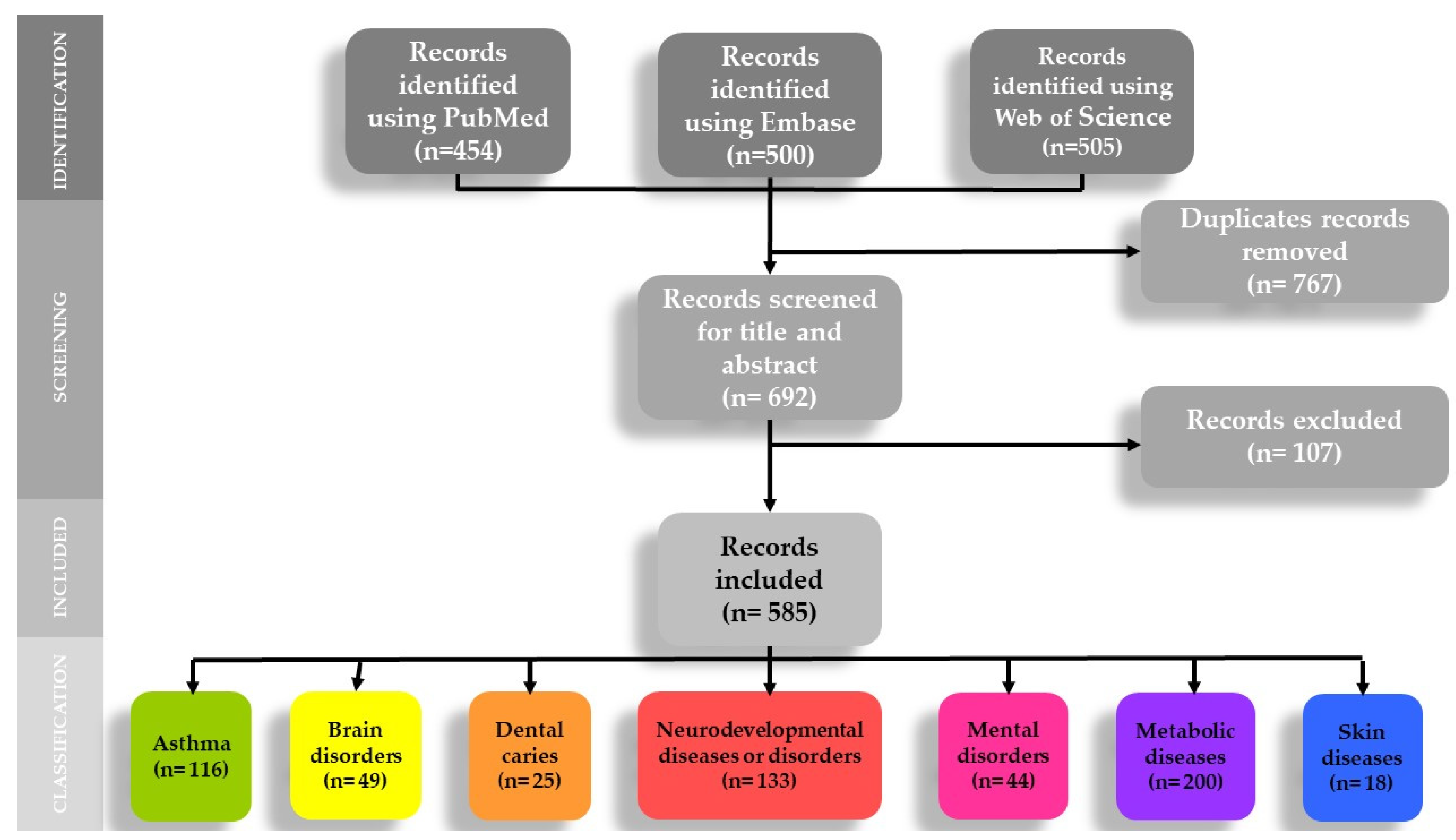
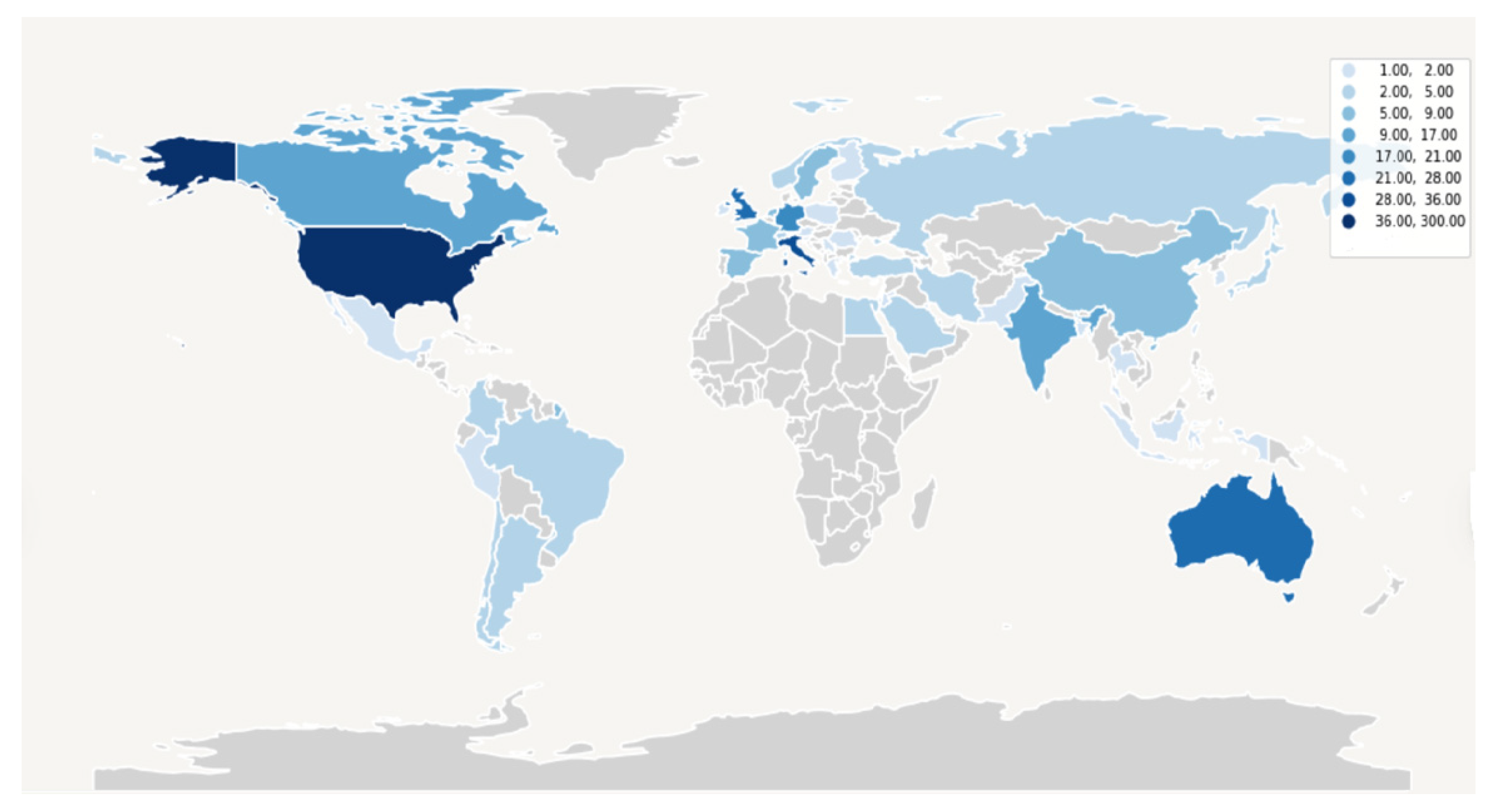
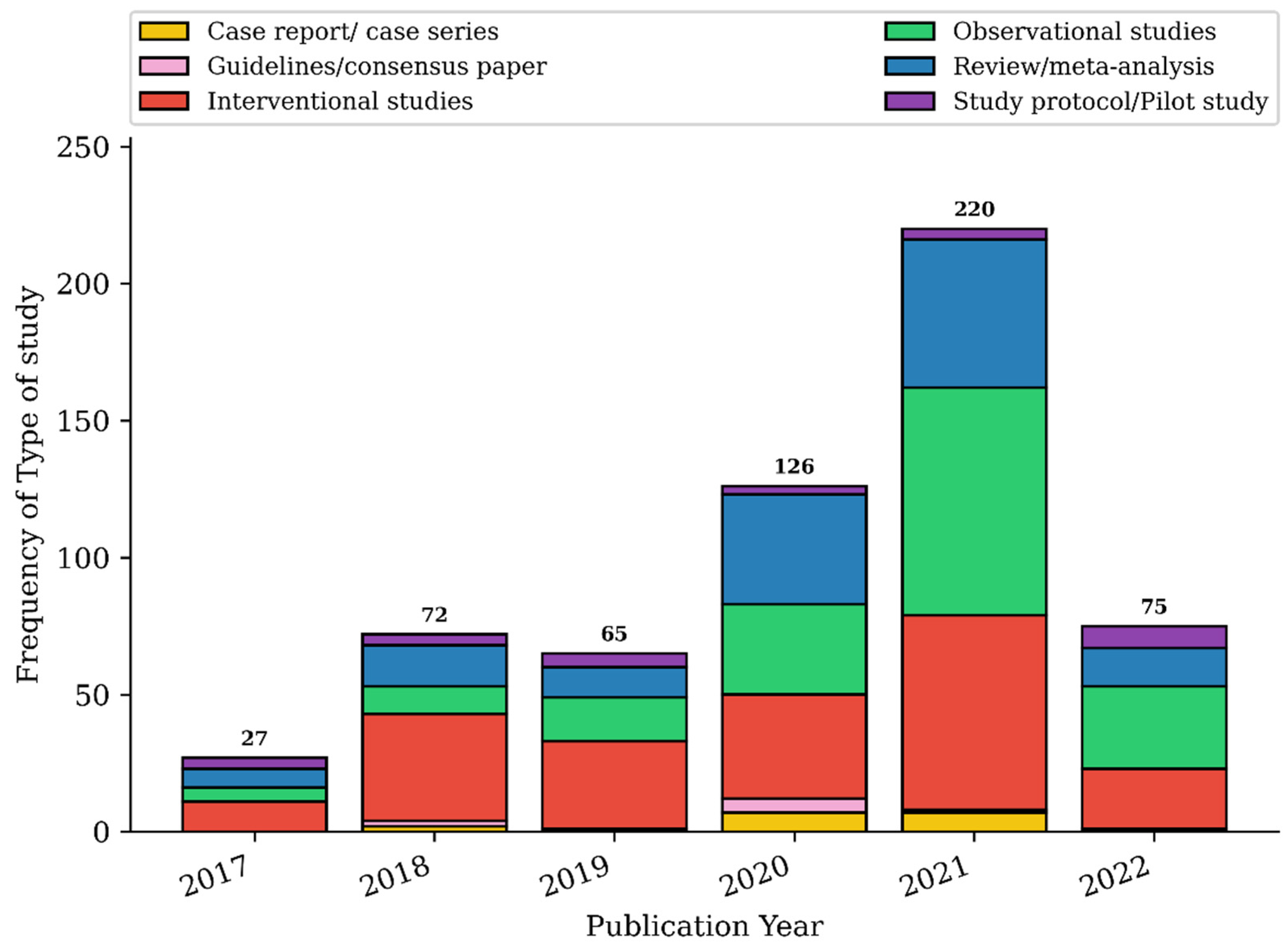
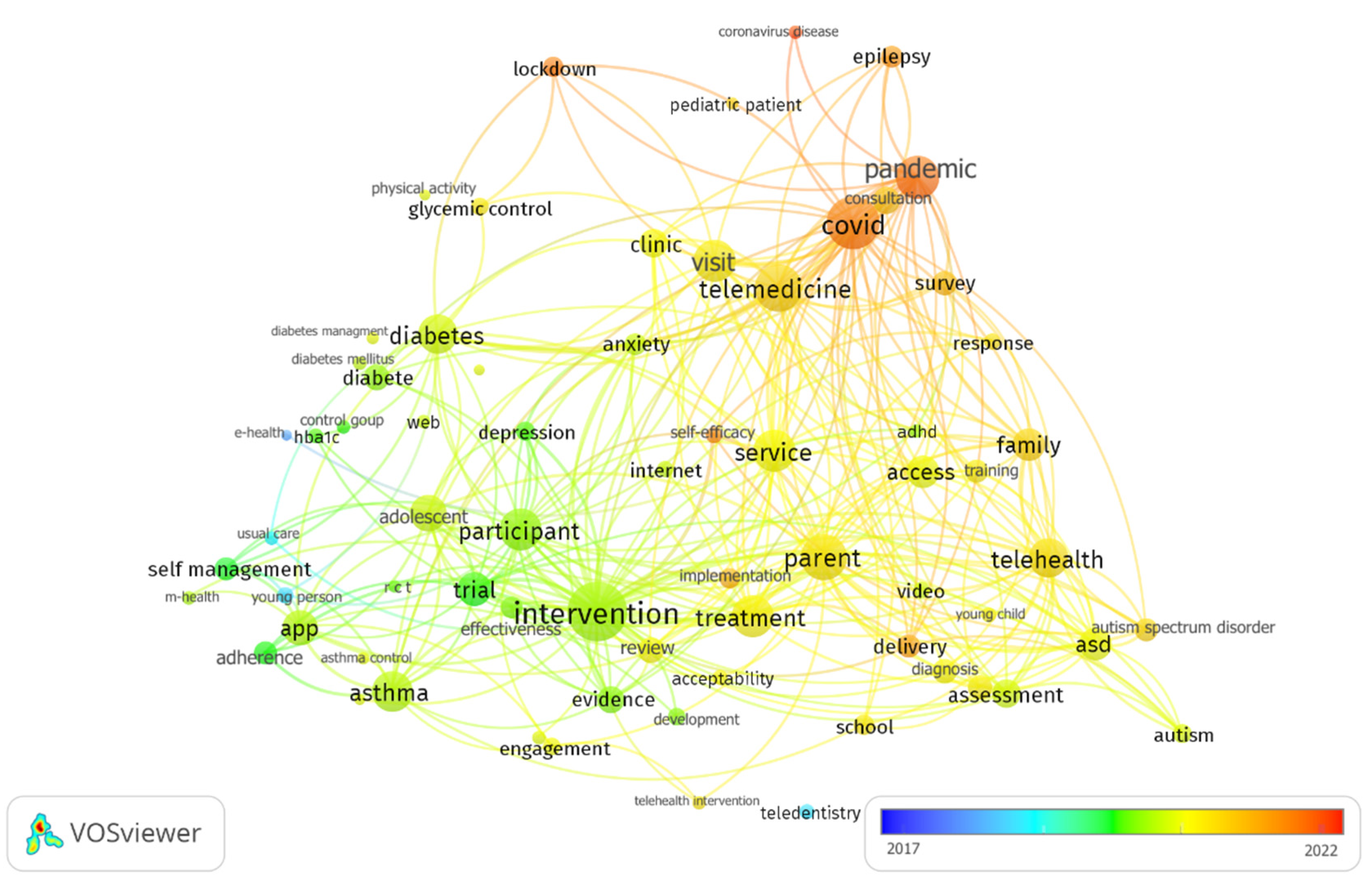
| Variable | Publication Years 2020–2022 | Publication Years 2017–2019 | p-Value |
|---|---|---|---|
| (n = 421) | (n = 164) | ||
| Continent | |||
| Africa | 3 (0.71%) | 0 (0.00%) | 0.001 * |
| Asia | 46 (10.93%) | 7 (4.26%) | |
| Europe | 110 (26.13%) | 42 (25.61%) | |
| Oceania | 11 (2.61%) | 17 (10.37%) | |
| North America | 225 (53.44%) | 88 (53.66%) | |
| South America | 14 (3.33%) | 5 (3.05%) | |
| More than one continent | 12 (2.85%) | 5 (3.05%) | |
| Total | 421 (100.00%) | 164 (100.00%) | |
| Type of publication | |||
| Journal article | 331 (78.62%) | 132 (80.49%) | 0.183 |
| Book chapter | 0 (0.00%) | 1 (0.61%) | |
| Comment/editorial/letter | 11 (2.62%) | 7 (4.27%) | |
| Conference abstract | 79 (18.76%) | 24 (14.63%) | |
| Total | 421 (100.00%) | 164 (100.00%) | |
| Topic | |||
| Asthma | 77 (18.29%) | 39 (23.78%) | <0.001 * |
| Brain disorders | 44 (10.45%) | 5 (3.05%) | |
| Dental caries | 13 (3.09%) | 12 (7.32%) | |
| Mental disorders | 26 (6.18%) | 18 (10.98%) | |
| Metabolic diseases | 143 (33.97%) | 57 (34.76%) | |
| Neurodevelopmental diseases or disorders | 108 (25.65%) | 25 (15.24%) | |
| Skin diseases | 10 (2.37%) | 8 (4.87%) | |
| Total | 421 (100.00%) | 164 (100.00%) | |
| Type of study | |||
| Case report/case series | 14 (3.33%) | 3 (1.83%) | <0.001 * |
| Guidelines/consensus paper | 7 (1.66%) | 2 (1.22%) | |
| Interventional study | 131 (31.12%) | 82 (50.00%) | |
| Observational study | 146 (34.68%) | 31 (18.90%) | |
| Review/Meta-analysis | 108 (25.65%) | 33 (20.12%) | |
| Study protocol/pilot study | 15 (3.56%) | 13 (7.93%) | |
| Total | 421 (100.00%) | 164 (100.00%) | |
| Clinical query | |||
| Prevention | 9 (2.13%) | 2 (1.22%) | 0.109 |
| Diagnosis | 38 (9.03%) | 17 (10.37%) | |
| Treatment | 149 (35.39%) | 73 (44.51%) | |
| Follow up | 176 (41.81%) | 50 (30.49%) | |
| Diagnosis and treatment/follow- up | 49 (11.64%) | 22 (13.41%) | |
| Total | 421 (100.00%) | 164 (100.00%) |
| Variable | n | Mean | 95% CI | SD | Range | p-Value |
|---|---|---|---|---|---|---|
| Times cited count in Embase/WOS | ||||||
| 2020–2022 | 421 | 5.54 | 4.23; 6.86 | 13.71 | 0.00–192.00 | <0.001 * |
| 2017–2019 | 164 | 14.71 | 12.07; 17.36 | 17.16 | 0.00–79.00 | |
| 2020 Impact Factor | ||||||
| 2020–2022 | 359 | 4.58 | 4.28; 4.87 | 2.82 | 0.06–21.60 | 0.709 |
| 2017–2019 | 135 | 5.46 | 4.67; 6.24 | 4.62 | 0.27–32.07 | |
Publisher’s Note: MDPI stays neutral with regard to jurisdictional claims in published maps and institutional affiliations. |
© 2022 by the authors. Licensee MDPI, Basel, Switzerland. This article is an open access article distributed under the terms and conditions of the Creative Commons Attribution (CC BY) license (https://creativecommons.org/licenses/by/4.0/).
Share and Cite
Camoni, N.; Cirio, S.; Salerno, C.; Balian, A.; Bruni, G.; D’Avola, V.; Cagetti, M.G. COVID-19 Pandemic and Remote Consultations in Children: A Bibliometric Analysis. Int. J. Environ. Res. Public Health 2022, 19, 9787. https://doi.org/10.3390/ijerph19169787
Camoni N, Cirio S, Salerno C, Balian A, Bruni G, D’Avola V, Cagetti MG. COVID-19 Pandemic and Remote Consultations in Children: A Bibliometric Analysis. International Journal of Environmental Research and Public Health. 2022; 19(16):9787. https://doi.org/10.3390/ijerph19169787
Chicago/Turabian StyleCamoni, Nicole, Silvia Cirio, Claudia Salerno, Araxi Balian, Giulia Bruni, Valeria D’Avola, and Maria Grazia Cagetti. 2022. "COVID-19 Pandemic and Remote Consultations in Children: A Bibliometric Analysis" International Journal of Environmental Research and Public Health 19, no. 16: 9787. https://doi.org/10.3390/ijerph19169787
APA StyleCamoni, N., Cirio, S., Salerno, C., Balian, A., Bruni, G., D’Avola, V., & Cagetti, M. G. (2022). COVID-19 Pandemic and Remote Consultations in Children: A Bibliometric Analysis. International Journal of Environmental Research and Public Health, 19(16), 9787. https://doi.org/10.3390/ijerph19169787







